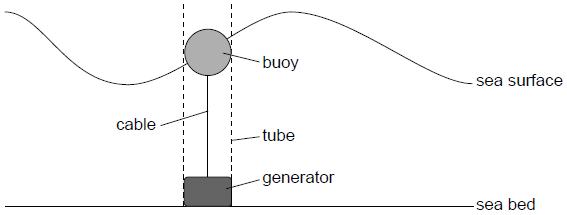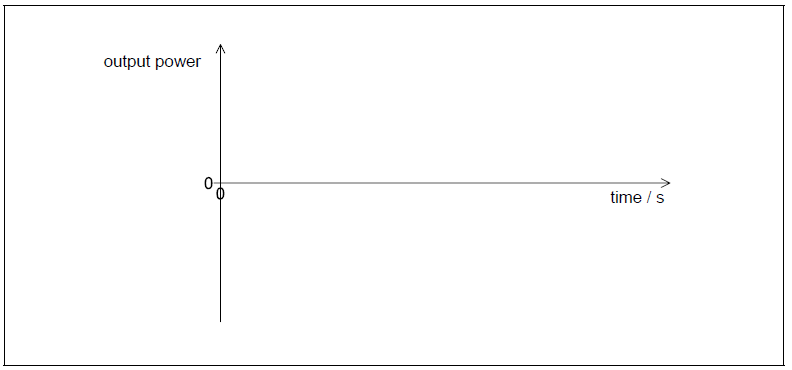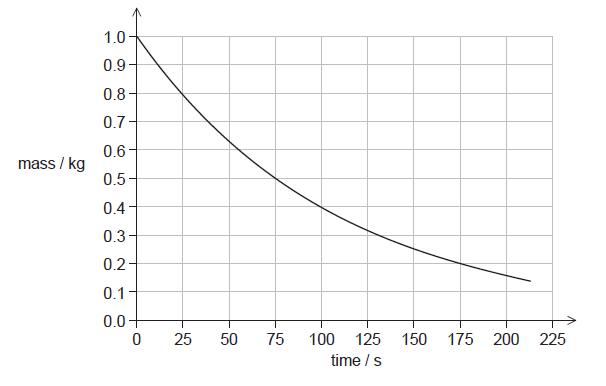
Topic 8 - Energy Production
Question 1
HLPaper 2A buoy, floating in a vertical tube, generates energy from the movement of water waves on the surface of the sea. When the buoy moves up, a cable turns a generator on the sea bed producing power. When the buoy moves down, the cable is wound in by a mechanism in the generator and no power is produced.

The motion of the buoy can be assumed to be simple harmonic.
Water can be used in other ways to generate energy.
Outline the conditions necessary for simple harmonic motion (SHM) to occur.
A wave of amplitude 4.3 m and wavelength 35 m, moves with a speed of 3.4 m/s. Calculate the maximum vertical speed of the buoy.
Sketch a graph to show the variation with time of the generator output power. Label the time axis with a suitable scale.

Outline, with reference to energy changes, the operation of a pumped storage hydroelectric system.
The water in a particular pumped storage hydroelectric system falls a vertical distance of 270 m to the turbines. Calculate the speed at which water arrives at the turbines. Assume that there is no energy loss in the system.
The hydroelectric system has four 250 MW generators. Determine the maximum time for which the hydroelectric system can maintain full output when a mass of kg of water passes through the turbines.
Not all the stored energy can be retrieved because of energy losses in the system. Explain two such losses.

Question 2
HLPaper 2Titan is a moon of Saturn. The Titan-Sun distance is times greater than the Earth-Sun distance.
The molar mass of nitrogen is .
Show that the intensity of the solar radiation at the location of Titan is .
Titan has an atmosphere of nitrogen. The albedo of the atmosphere is 0.22. The surface of Titan may be assumed to be a black body. Explain why the average intensity of solar radiation absorbed by the whole surface of Titan is .
Show that the equilibrium surface temperature of Titan is about .
The mass of Titan is 0.025 times the mass of the Earth and its radius is 0.404 times the radius of the Earth. The escape speed from Earth is 11.2 km/s. Show that the escape speed from Titan is 2.8 km/s.
The orbital radius of Titan around Saturn is and the period of revolution is .
Show that where is the mass of Saturn.
The orbital radius of Titan around Saturn is m and the orbital period is 15.9 days. Estimate the mass of Saturn.
Show that the mass of a nitrogen molecule is kg.
Estimate the root mean square speed of nitrogen molecules in the Titan atmosphere. Assume an atmosphere temperature of .
Discuss, by reference to the answer in (b), whether it is likely that Titan will lose its atmosphere of nitrogen.
Question 3
SLPaper 2Two renewable energy sources are solar and wind.
An alternative generation method is the use of wind turbines. The following data are available:
- Length of turbine blade = 17 m
- Density of air = 1.3 kg m
- Average wind speed = 7.5 m s
Describe the difference between photovoltaic cells and solar heating panels.
A solar farm is made up of photovoltaic cells of area . The average solar intensity falling on the farm is and the average power output of the farm is 1.6 MW. Calculate the efficiency of the photovoltaic cells.
Determine the minimum number of turbines needed to generate the same power as the solar farm.
Explain two reasons why the number of turbines required is likely to be greater than your answer to (c)(i).
Question 4
SLPaper 1Three energy sources for power stations are
- I. fossil fuel
- II. pumped water storage
- III. nuclear fuel.
Which energy sources are primary sources?
Question 5
SLPaper 1Which change produces the largest percentage increase in the maximum theoretical poweroutput of a wind turbine?
Question 6
SLPaper 1The three statements give possible reasons why an average value should be used for the solar constant.
- I. The Sun's output varies during its 11 year cycle.
- II. The Earth is in elliptical orbit around the Sun.
- III. The plane of the Earth's spin on its axis is tilted to the plane of its orbit about the Sun.
Which are the correct reasons for using an average value for the solar constant?
Question 7
HLPaper 2One possible fission reaction of uranium-235 (U-235) is
Mass of one atom of U-235
Binding energy per nucleon for U-235
Binding energy per nucleon for Xe-140
Binding energy per nucleon for Sr-94
A nuclear power station uses U-235 as fuel. Assume that every fission reaction of U-235 gives rise to of energy.
A sample of waste produced by the reactor contains of strontium-94 (Sr-94). Sr-94 is radioactive and undergoes beta-minus () decay into a daughter nuclide X. The reaction for this decay is
The graph shows the variation with time of the mass of Sr-94 remaining in the sample.

State what is meant by binding energy of a nucleus.
a(i).
Outline why quantities such as atomic mass and nuclear binding energy are often expressed in non-SI units. a(ii).
Show that the energy released in the reaction is about . a(iii).
Estimate, in , the specific energy of U-235. b(i).
The power station has a useful power output of GW and an efficiency of . Determine the mass of U-235 that undergoes fission in one day.
b(ii).
The specific energy of fossil fuel is typically MJ . Suggest, with reference to your answer to (b)(i), one advantage of U-235 compared with fossil fuels in a power station. b(iii).
Write down the proton number of nuclide X. c(i).
State the half-life of . c(ii).
Calculate the mass of Sr-94 remaining in the sample after minutes. c(iii).
Question 8
HLPaper 1The average albedo of glacier ice is 0.25.
What is ?
Question 9
HLPaper 2There is a proposal to place a satellite in orbit around planet Mars.
The satellite is to have an orbital time T equal to the length of a day on Mars. It can be shown that
where R is the orbital radius of the satellite and k is a constant.
The ratio .
Outline what is meant by gravitational field strength at a point.
Newton's law of gravitation applies to point masses. Suggest why the law can be applied to a satellite orbiting Mars.
Mars has a mass of kg. Show that, for Mars, is about .
The time taken for Mars to revolve on its axis is 8.9 × 104s. Calculate, in m s–1,the orbital speed of the satellite.
Show that the intensity of solar radiation at the orbit of Mars is about 600 W m–2.
Determine, in K, the mean surface temperature of Mars. Assume that Mars acts as a black body.
The atmosphere of Mars is composed mainly of carbon dioxide and has a pressure less than 1% of that on Earth. Outline why the mean temperature of Earth is strongly affected by gases in its atmosphere but that of Mars is not.
Question 10
HLPaper 1A nuclear particle has an energy of eV. A grain of sand has a mass of 32 mg. What speed must the grain of sand have for its kinetic energy to equal the energy of the nuclear particle?
